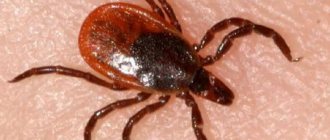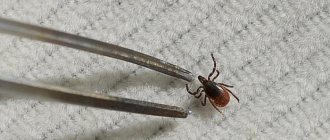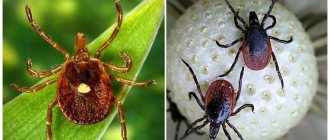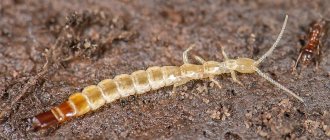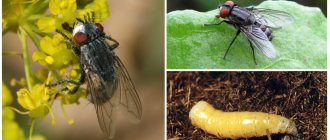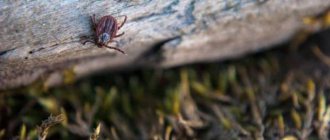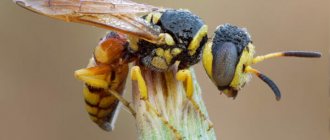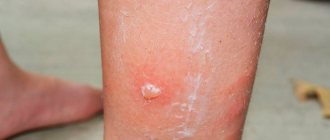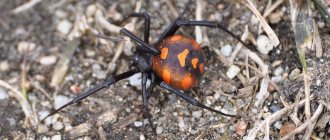In previous articles, we examined in detail such representatives of the ixodid family as taiga and dog ticks, which are most common in the central zone of our country. Having the ability to infect humans with complex infectious diseases, they attract more attention from us.
However, the Ixodid family includes another type of tick, which has many names - deer, bear, black-legged or simply black tick. This type of parasite does not officially live on the territory of our continent; its habitat is mainly North America. But it is worth noting that single representatives of the parasite can be found on any landmass of the planet, with the exception of regions with permafrost.
Considering the peculiarities of the distribution of the black tick, the material in this article may be useful to tourists, travelers, as well as those readers who want to broaden their horizons in the field of entomology of ixodid ticks.
General information about the black mite
The black-legged tick (Ixodes scapularis) is commonly known as the deer tick, black-legged tick, or black-legged tick due to the intense lacquered black coloring of its limbs. The tick's habitat is primarily on the west coast of the United States, but is found throughout the continent. Like most members of the ixodid family, the black tick is a carrier of several animal and human diseases - Lyme disease, babesiosis, anaplasmosis and others. The true host of the black tick is the white-tailed deer, and it is precisely because the parasite is most often found on this animal that it has earned its second name, the deer tick. The tick also attacks mice, lizards and migratory birds; this phenomenon is especially often observed at the larval or nymphal stage of the parasite.
Ixodid ticks / Ixodida
The most dangerous family of ticks, numbering more than 650 species, belongs to the large order Ixodida.
These small creatures are dangerous because they are carriers of diseases that are fatal to humans - tick-borne encephalitis and tick-borne borreliosis (Lyme disease). These tiny animals live in all corners of our planet, and even in Antarctica they parasitize the bodies of penguins and birds. Adults grow up to 4 mm, and when filled with blood, reach a size of 10 mm. In Russia, ticks are found almost everywhere, except in arid places.
https://www.youtube.com/watch?v=upload
One clutch can contain up to 15 thousand eggs, but only a few survive during development. These dangerous creatures live from 2 to 3 years.
Features of behavior
I. scapularis has a life cycle of two years, during which it passes through three stages: larva, nymph and adult. The tick must take a portion of blood at each stage of its life cycle before maturation, otherwise the transition to the next stage will be impossible.
The black tick is one of the species of ixodids in which the process of feeding on blood takes a long time. After landing on a victim, the parasite quickly finds a place to bite, but the process of taking blood continues for four to five days. As noted above, white-tailed deer are the preferred host of the black tick, but they are also well known to attack small rodents.
After the parasite gets drunk, it falls to the ground and hibernates in the fallen leaves of the undergrowth. The following spring, the female lays several hundred to several thousand eggs in clusters.
Ixodid ticks are very hardy creatures and I. scapularis is no exception. They are active even after severe frosts, since daytime temperatures can warm them enough to keep them in the desired host-seeking activity. In the spring, they may be one of the first invertebrate animals to emerge after winter.
Measures to combat kidney mites
To get rid of the pest, diseased buds are removed from the bush, the plants are treated, and the rules of agricultural technology are followed. Control measures can be combined to increase their effectiveness.
Removing buds and shoots
In early spring (in the middle or second half of April), when enlarged buds are detected, infected shoots are cut and burned. After destroying the affected part of the plant, the bush produces new healthy growth. There are no pests in the soil.
Bush processing
Plant processing involves the use of folk remedies, biological and chemical preparations, among which organophosphorus compounds are isolated due to their high toxicity.
Folk remedies
Before the bushes begin to bud, the plant can be treated with hot water. The optimal temperature is +80 °C. One bucket of water is consumed per adult bush. This is one of the most affordable and safest ways to combat pests.
Currants are treated during the flowering period (second half of May) and after it with a lime-sulfur solution or a solution of colloidal sulfur suspension, for which 75 g of the suspension is dissolved in 10 liters of water.
Common folk remedies for treating the plant are infusions (the ingredients are mixed with 10 liters of water):
| Name of the infusion | Ingredients | Infusion time, hours |
| Garlic | 200 g minced garlic | 3 |
| Mustards | 200 g mustard powder | 8 |
| Dandelion | 200 g roots and 50 g leaves, minced in a meat grinder | 2 (stirring) |
Before use, the infusions are filtered.
Chemicals
The use of acaricides or insectoacaricides (Apollo, Kontos) is allowed. Spraying is carried out at intervals of 10 days two or three times. The air temperature should be above +5 °C with low air humidity and no wind. The last one is during the budding period.
Organophosphorus compounds
Organophosphorus agents (Phosfamide, Nitrafen) are allowed to be used only after harvesting.
Biological drugs
Biological agents (Fitoverm, Aktofit) are effective at temperatures above +19 °C in dry air and calm air. It is recommended to carry out three treatments with an interval of seven days. It is useful to alternate and combine biological products with biofungicides.
In autumn, bushes are sprayed with any acaricides.
Consequences of a bite
In addition to Lyme disease, or borreliosis, the black tick is dangerous to humans as a carrier of several other types of pathogens, such as Theileria microti and Anaplasma phagocytophilum, which cause the diseases babesiosis and human granulocytic anaplasmosis, respectively. Concurrent infections are often possible—among early patients with Lyme disease, depending on their geographic location, 2-12% also have anaplasmosis and 2-40% have babesiosis. Co-infection will complicate Lyme symptoms, but diagnosis and treatment are especially difficult in this case.
Although large mammals are the preferred hosts of ticks, deer cannot transmit Lyme disease pathogens to ticks. They acquire Borrelia while feeding in their early stages on infected mice and other small rodents.
Guinea fowl, backyard chickens, and fire ants are known predators of mites. However, in the wild, an increase in populations of this ant species has no effect on reducing the concentration of mites.
Dog tick / Ixodes ricinus
In addition to encephalitis and Lyme disease, this species of tick is a carrier of Marseille fever and tularemia.
The most dangerous areas for dog ticks are in Europe and Asia, but small populations also live in North America and Africa.
The body color of Ixodes ricinus is brown with a small dark spot, but the limbs are much darker than the body. They grow no more than 4 mm, and when filled with blood, nymphs can reach 11 mm.
It is a mistake to believe that these animals only bite dogs. They also pose a danger to other animals, including humans.
A fairly common genus of ticks of the subfamily Amblyomminae, which, in addition to the forest zone, can also live in the steppe. They pose a danger to the life of humans and mammals because they can be carriers of fatal diseases. Let's introduce several subspecies...
Some features of the black tick development cycle
Black mites live for two to three years and feed only three times in their entire lives. The life cycle begins when the female lays eggs. As the eggs mature, they hatch into larvae, which then molt into nymphs and finally, also through the molting process, the nymphs emerge into adults.
Larvae emerge from eggs, as a rule, from May to September, that is, the entire warm period of the season. Here are a few characteristics of this stage of the mite:
- initially the larva is sterile, it does not carry pathogens of diseases such as Lyme disease, human anaplasmosis or babesiosis;
- the first causative agent of the disease, the larva receives a portion of blood from the carrier or sick host during its intake;
- the larvae usually attack white mice, voles, or bite the legs of other small mammals;
- if a mouse is infected with pathogens, the larva becomes infected and is now able to transmit these pathogens during its second or third feeding (nymph or adult stage);
- immediately after feeding, the larvae molt into nymphs and become passive until the following spring.
In the spring and summer of the second year, primarily from May to early July, the nymph becomes active and feeds for the second time in its life. Peculiarities:
- If a tick carries a pathogen acquired during its first feeding as a larva, it may transmit the pathogen during its second feeding.
- If the nymph has not yet been infected, it may become infected if the second host carries pathogens.
- The nymph is the size of a poppy seed. Therefore, it is very difficult to distinguish them externally; they often look like a speck of dirt or freckles on human skin.
Description
Most images of Ixodes scapularis show an adult that has not consumed food. This is natural because black-legged ticks are removed immediately upon discovery to minimize the likelihood of disease.
Typically, the abdominal cavity, which contains blood, is much larger when feeding. Consequently, a swollen I. scapularis parasite (see photo below) can easily be mistaken for an entirely different tick.
When a black tick consumes blood, its abdomen is a light grayish-blue color. When identifying a live parasite, it is helpful to focus on the legs and upper body.
The red mite belongs to the spider mites, which are known as dangerous pests. This species is capable of destroying agricultural crops, gardening, and even house plants. The name "spider" comes from the way it destroys culture. The whole point is that when they appear on a flower, the leaves and stems are enveloped in cobwebs, and then they suck out the juice and the plant dies.
There are several varieties of this pest, here are the most common:
- Ordinary. This parasite settles on leaves, branches, shoots, and fruits. It has a bright red color, maybe orange.
- Red. It is very dangerous for indoor flowers and affects them indoors. Females are purple red, males are bright red.
- Red-footed. Settles on ornamental plants. Has an orange color.
- Atlantic. A very common pest that affects cucumber plantings.
If this parasite appears on a plant, a cobweb is observed on the leaves and stems. Also, light dots appear on the leaves; they are formed as a result of pest bites. The larger the cluster of ticks, the more noticeable the affected areas. The leaves eventually fade to a pale yellow color, then they begin to fall off. This leads to the fact that the plant begins to hurt and weaken.
A small bug that a person can notice due to its color. The size of the bug is no more than 1 millimeter, the body is white or gray, but the legs are red-brown. They lack organs of vision, but this does not at all prevent them from moving quickly and achieving their goal. It is worth mentioning studies in which it was found that exposure of a tick to radioactive radiation does not lead to its death.
These insects move very well on horizontal and vertical surfaces. Regarding the life cycle, it is quite short, but during this short period, females are capable of laying several hundred eggs. They adapt perfectly to any climatic conditions and are not afraid of either low or high temperatures.
Where do they live?
Generally speaking, their habitat is where there is any food. Since they can easily adapt to any conditions, it doesn’t matter to them exactly where they settle, the main thing is that they have something to eat. Insects infest warehouses, shops, factories, and kitchens. Quite often found in barns and pens where livestock live, since rotting wood, remains of straw and plant food are a favorable environment for reproduction and life.
Colonies of flour mites are very dangerous, since a large number of parasites can harm not only all food supplies, but also will not disdain medicines and even tobacco. Therefore, the fight against them must begin as soon as they are noticed.
How does it reproduce?
If they can live in any room, then special conditions are required for reproduction. For example, there should be enough organic substances, the ideal temperature regime is 18-27°, the humidity level plays a big role, it should be at least 15% and no more than 18%. In addition, there should be no direct exposure to sunlight.
Under these conditions, the female lays eggs when the incubation period ends and a larva emerges from each egg. Already at this stage, the larva has a good appetite, and it needs to eat regularly and a lot in order to develop and grow into a young individual. The development process includes two molts. The larva does not have a shell or bristles, and its size is very small.
Several days pass from the time the egg hatches until it transforms into a first instar nymph. It increases in size and becomes more like an adult. After a week, molting occurs, the time of the second generation comes, and after a few days a full-fledged young individual appears that can reproduce.
Some facts about the black tick
- Black ticks feed on blood by inserting their proboscis into the wound, which is equipped with sharp growths that prevent the tick from falling off until the feeding process is completed.
- They are very slow bloodsuckers - to get their fill of blood, they need a period of 3-5 days.
- If black-legged ticks are infected with an infectious agent, the blood-sucking time must take at least 24-48 hours before the parasite is able to infect a person with Lyme disease. Human anaplasmosis takes slightly less time to become infected - at least 12-24 hours.
- Ticks live in wooded, brushy areas that provide food and cover for populations of white mice, deer and other mammals.
- This habitat also provides the parasites with the moisture levels they need to survive.
- The highest concentration of ticks is in the forest (especially along highways) and grass areas at the forest border.
- Ticks wait for potential prey at the tips of low-lying vegetation and the lower branches of shrubs. They don't crawl into trees.
- Typically, ticks attach to a person or animal near ground level.
- Like all ixodids, black ticks only crawl, they do not jump or fly. They grab with their front paws the clothes of people or the fur of animals that pass by, and then the bloodsuckers crawl up to find a place to bite.
- White-tailed deer live throughout most of the United States, but the black-legged tick can only be found in certain regions of the country.
Prevention measures
In most cases, soil mites are found in bulbous flowers. When purchasing planting material, you must carefully inspect the bulbs. They should be dense, without stains or putrefactive damage. When replanting new plants, remove them from the pot and wash the roots. Containers for flowers are treated with boiling water or placed in a microwave oven for 2 minutes. Infected crops are reduced from healthy until the pests are completely destroyed.
To prevent the density of the mite population from increasing and exceeding the permissible level, it is necessary to ensure good drainage in the pot, avoid excessive watering and prevent stagnation of water in the trays.
It is better to prevent any problem than to deal with its consequences later, so you should not neglect preventive measures in the process of growing indoor plants. It is necessary to properly store planting material, disinfect it, control the soil moisture level and install a drainage system in the pots.
How to protect yourself from a tick bite
Black ticks live in shady, damp areas at ground level. They will cling to tall grass, inflorescences and bushes, usually no more than one and a half meters from the ground. They are also abundant in lawns and gardens, especially along woodland edges and around old stone walls. As already noted, parasites cannot fly or jump, nor do they fall on passing people or animals. All the conditions discussed below will be true for “our” parasites - taiga and dog ticks.
In tick-infested areas, the best defense against the parasite is to avoid contact with soil, leaf litter and vegetation. However, if there is a need to hike, camp, hunt, or otherwise spend time outdoors, everyone can protect themselves by:
- Wear light-colored clothes made of thick fabric. It's so easy to see the tick.
- Wear high-top shoes with the legs tucked in and a long-sleeved shirt.
- Check clothing and any exposed skin as often as possible while outdoors.
- Consider using repellents.
- Try to move on cleared, well-trodden trails in their center. Avoid dense forests and bushy areas.
- Avoid sitting directly on the ground or on rock walls.
- Keep long hair tied up.
- Shower as soon as possible after returning indoors, preferably within two hours, to wash off or easily locate any ticks that may be on your body.
- Do a final, full body check at the end of the day. Children and pets should also be checked. Found ticks must be destroyed.
Folk remedies
Effectively fights tansy mites. Bulbous and corm plants, cleared of soil, are soaked in an infusion of herbs. For preparation, take 150 g of fresh herbs or 25 g of dried raw materials. Tansy is poured into 0.5 liters of hot water, left for 20 minutes and diluted with clean water in a 1:1 ratio. Plants are kept in the solution for 15-30 minutes.
Wood ash is used to spray plants and top layers of soil. In 5 liters of water, infuse 1 tbsp. l. ash during the day. Add 50 g of crushed laundry soap to the composition. An infusion of alder leaves helps against root mites. Boiling water (1 l) is poured into 1 tbsp. l. finely chopped leaves and infused for 36 hours. Before planting, plant roots and bulbs are soaked in a heated infusion (up to 45 °C) for 8 minutes.
Spraying crops with garlic infusion repels pests. Place two crushed heads of garlic in a glass container, add 1 liter of water, seal tightly and leave for 5 days in a dark place. Before spraying, the solution is diluted 1:1 with water. The healing properties of herbs strengthen plants, making them resistant to pathogens, adverse conditions and pests.
What chemicals are best for protection against ticks?
The following drugs have the most effective acaricidal effects against ixodid ticks:
- DEET. Such substances can be applied to exposed skin. Products containing 20% or more DEET may provide protection that lasts up to several hours. Use the lowest concentration needed for the amount of time you plan to spend outdoors.
- Picaridin is a colorless and odorless ingredient that can be applied to exposed skin at levels ranging from 5 to 20% of the active ingredient.
- Permethrin. Clothing, shoes and personal items can be treated with products containing permethrin. Its protection can last for many washes. Never use permethrin on your skin.
Precautions when using repellents that contain these active ingredients:
- Keep all anti-tick products out of the reach of children and read all label instructions before applying.
- Do not allow children to apply repellents on themselves.
- Do not apply repellents directly to the skin of the body. First you need to apply the product to the palms of your hands. And then treat the skin of the body. The exception is sprays.
- When using repellents, avoid contact with the eyes, mouth and nasal cavity.
- Do not apply repellents to skin damaged by sunburn, cuts, bruises, or other conditions such as psoriasis.
- Avoid prolonged and excessive use of repellents.
- Do not use repellents in enclosed spaces.
- Do not apply them directly to your face.
- Do not apply near eyes, nose or mouth.
- Wash treated skin upon return.
- If you think you or your child have had an adverse reaction to a repellent, wash the treated area immediately and contact your local health care provider.
Grass mite / Dermacentor marginatus
A dangerous type of tick that can be found in the steppe zone is a carrier of tick-borne typhus and many other dangerous diseases, including encephalitis and Omsk fever.
Dermacentor marginatus parasitizes large domestic animals, as well as some inhabitants of the forest-steppe zone, such as hares or hedgehogs. The length of an adult reaches 4-5 mm, and when filled with blood up to 15 mm.
This species is dangerous because adult individuals often attack people, so it is necessary to carry out preventive measures to clear the areas around the home, and treat tents with special preparations.
How to safely remove a tick
If you find an embedded tick, there is no need to panic. Not all ticks are infected, and your risk of contracting an infection is greatly reduced if the tick is removed within the first 36 hours.
To remove a tick:
- Use simple tweezers to grasp the tick as close to the surface of the skin as possible.
- Pull firmly and steadily vertically upward. Do not pull or twist the tick.
- Place the parasite in a small container of alcohol to kill it. Or just burn it.
- Clean the bite area with alcohol, hydrogen peroxide, or iodine.
The bite site should be monitored over the next 30 days for the appearance of a rash. If a rash or flu-like symptoms begin to appear, contact your doctor immediately. Although it is not generally recommended that you take antibiotics for three days after a tick bite, it may be helpful for some people. This applies to tick bites that occurred in areas where Lyme disease is common and there is evidence that the tick was bitten for more than one day.
Why is the red tick dangerous for humans?
This little bug is capable of causing enormous harm. It is very dangerous for grain crops, as it can reduce yields several times. In addition, it is dangerous because its waste products contain pathogenic microorganisms, including E. coli. It eats grains, cereals, flour, a variety of dried fruits and will not pass by meat waste.
Where the flour mite has visited, food becomes unfit for consumption, since there is a high risk of infection. The mildest consequences include poisoning and allergic reactions. But unfortunately, there is a possibility of infection with scabies, Lyme disease, and urticaria. In addition, diseases of the respiratory tract and genitourinary system may occur.
The parasite's diet consists of the juice of a variety of crops. It does not pose any danger to humans and animals. In addition, the structure of the oral apparatus does not make it possible to bite through the skin, so bites are excluded. But it can harm people from an economic point of view on a huge scale.
The size of the tick is so small that it is impossible to immediately see it on your body. The parasite's saliva contains an anesthetic substance, so the victim does not feel the bite at all. He can only be discovered after he drinks blood. Drinking blood makes him bloated. The body size increases 3 times, then it disappears. This usually happens on day 4-5. The first symptoms indicating the presence of a tick appear a few hours after the bite in the form of:
- headache;
- subcutaneous itching or rash;
- high body temperature;
- enlarged lymph nodes.
If such symptoms appear, it means that the infection has entered the bloodstream and the infection process has begun. The danger of a bite is that the parasite can be a carrier of serious diseases, such as:
- Monocytic ehrlichiosis. Joint pain, fatigue, high body temperature are the main symptoms of the disease. When the disease begins to progress, the functioning of the central nervous system and musculoskeletal system is disrupted. In this case, the destruction of blood vessels occurs.
- Encephalitis. The first symptoms of the disease are headaches, chills, and fever up to 39-40 °C, which is why encephalitis is often confused with ARVI. After a few days, vomiting, photophobia appears, the tongue becomes covered with a white coating, the liver and spleen become enlarged. The incubation period is 7-20 days. If not treated in a timely manner, the infection affects the brain, leading to loss of speech and memory. Sometimes mental disorders and epilepsy develop.
- Tularemia. The bite site swells and the wound becomes open. Chills, vomiting, severe headaches appear, and the lymph nodes increase in size. Subsequently, peritonitis, pneumonia or gangrene develops.
- Tick-borne borreliosis. The disease occurs in three stages. Initially, a red ring forms at the site of the bite, the edges of which rise above the healthy skin. Its diameter is about 10 cm. Gradually, the central part of the skin acquires a pale tint, then turns blue. A crust appears on the wound and becomes scarred. After 3 weeks, the spot disappears. The second stage appears after 2-3 months. Muscle pain, arthritis, and heart rhythm become erratic. If treatment is not carried out, the disease progresses to the third chronic form, which is accompanied by complications in the form of dermatitis, polyarthritis, and damage to the nervous system.
- Hemorrhagic fever. Some animals are carriers of hemorrhagic fever. After drinking their blood, the tick becomes infected with this disease, subsequently transmitting it to humans. The infection destroys the walls of blood vessels, leading to death.
- Babesiosis. After being bitten by an infected parasite, a person feels constant malaise and fatigue. There is an aversion to food, chills and fever appear. The virus causes kidney and liver failure.
- Typhus. This is an acute infectious disease, accompanied by fever and rash, which appears on the third day. Sometimes consciousness is disturbed, insomnia and convulsions appear. After 2 weeks the person recovers completely. The carriers of the infection are ixodid ticks and wild rodents: hamsters, mice, gophers. Typhus is localized only in Siberia and the Far East. Sometimes found in Central Asia.
Encephalitis is a disease transmitted by ticks.
You can become infected even with a short-term bite.
We suggest you read: What do dust mites eat?
Sometimes infected ticks enter the home through pets. To help your dog, you need to know how the disease transmitted through parasites manifests itself:
- Granulocytic anaplasmosis. The incubation period is 1-2 weeks. The disease manifests itself as a fever, lethargy, and loss of appetite. In severe cases, cough, diarrhea, and vomiting occur. This disease affects dogs over 8 years of age.
- Babesiosis (pyroplasmosis). Infection occurs in the first 24 hours after the bite. The pet loses appetite, lethargy and chills appear. Fighting breed dogs are susceptible to this disease. Recovery is slow if it is not treated promptly. The incubation period is 1-2 weeks.
- Demodecosis. The pet loses hair, ulcers and wounds appear all over the skin. If there is redness in the ears, accompanied by severe itching, a large amount of dark-colored sulfur is released, then this means ear demodicosis.
- Hepatozoonos. When a tick enters the gastrointestinal tract of an animal, it develops hepatozoonos. The first symptoms: mucous membranes lighten, muscle pain, chills, fever appear. The animal quickly loses weight. The duration of the incubation period is about 14 days.
- Cyclic thrombocypenia. The carrier of this disease is the tick Rhipicephalus sanguineus and other species. In dogs, the incubation period lasts up to 15 days. A severe form of the disease is accompanied by chills and high fever. In this case, the lymph nodes become enlarged, and sometimes the nose bleeds.
- Borreliosis. Infection of the body occurs 24 hours after the bite. The incubation period lasts 1 month. There are no obvious symptoms of the disease. The pet may refuse to eat, and there is an increase in lymph nodes.
- Monocytic ehrlichiosis. The carrier of the disease is the dog tick. After infection, the pet experiences weakness and lacks appetite, resulting in severe weight loss and fever. In the acute form of the disease, bleeding, vomiting occurs, purulent rhinitis, shortness of breath, and ataxia develop. Some animals begin to limp. The duration of the incubation period is 1-3 weeks.
Argasid mites / Argasidae
After descriptions and photos of the 5 most dangerous ticks in the world, we move on to other, no less dangerous species. Unlike its counterparts, the argas tick has soft skin, that is, it does not have a protective shell, like other species.
Perhaps because of this structural feature, Argasidae prefers to live in closed places, climbing into crevices, bird nests, caves, grottoes and burrows. It is active only at night, but in shady areas it can attack humans during the day.
The most dangerous individuals of this species are the Caucasian tick, which causes endemic relapsing fever when bitten; as well as the Settlement tick, which is a carrier of tick-borne typhus and borreliosis.
Subcutaneous mite
The most dangerous thing about this type of mite is that, as you can guess from the name, they can stay under human skin for a long time. But it’s scary that usually people don’t even know about its existence.
Only when the immune system is weakened, at the time of a cold or other infectious disease, does the tick begin to move deeper into the human body, causing pain, itching, redness and allergies.
https://www.youtube.com/watch?v=ytpolicyandsafetyru
Mostly ticks choose soft places, but the biggest problem for humans is when the parasites live under the skin of a person’s face.
Bed (linen, dust) mite
The last bed mite on our list (not to be confused with bed bugs) lives in close proximity to a person, in his home. Their peculiarity is that they do not live on the human body.
Their natural habitat is dust accumulations, feathers or fluff in clothing or pillows. It would seem that this is the most secluded and safest place for a person, but it can also be fraught with serious danger.
https://www.youtube.com/watch?v=channelUCS0bDCxfM2fLc5KMRS3E8NA
When settling in an apartment or country house, bed mites cause scabies and severe irritation. Many people mistakenly believe that they bite a person, causing unpleasant symptoms in the form of itching and redness. But these animals do not come into direct contact with humans. It's all because of their bowel movements. One individual can defecate up to 20 times per day.
